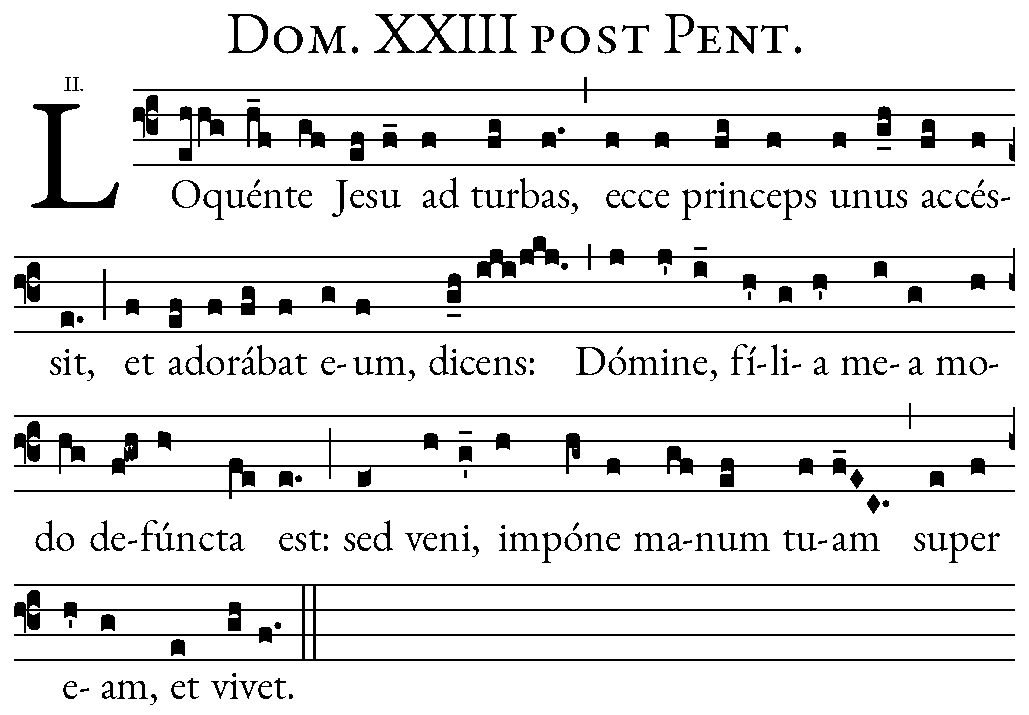On the Season of Pre-Advent

The Resumed Sundays after Epiphany
One of the peculiarities of the Traditional Liturgical Calendar is its inclusion of the ‘resumed’ Sundays after Epiphany. In years when there are more than 24 Sundays after Pentecost, the Sundays which were not observed after Epiphany are squeezed in between the 23rd and 24th Sundays after Pentecost. The 23rd Sunday, then, is the last ‘regular’ Sunday after Pentecost; all those that follow are, in a sense, Sundays-until-Advent. The 23rd Sunday, then, is the opening of pre-Advent.
Although this year, the Feast of Christ the King took precedence over the 23rd Sunday, the Gospel was said at the end of Mass on Sunday and this Mass has been repeated on the open ferial days of the week. The monks, then, have heard this first Mass of the season of Pre-Advent twice this week, including this very morning.
The 23rd Sunday after Pentecost
Thus, in approaching the season of Advent, the Gospel for the 23rd Sunday (Matt. 9) prepares us for this sacred season, particularly through the character of the ruler. First, he teaches us how to pray: approaching, adoring, and only then making petition, not long and drawn-out, but short and sweet with simple and pure faith (cf. Rule ch. 20): ‘Come, lay Thy hand upon her.’
Secondly, the ruler represents the fathers of old, who cried out in faith for their Messiah, while the daughter represents the world, dead in sin. As Veni is the word of the season in Advent, the ruler’s Veni anticipates that time when we will cry out all the more fervently: Veni, Veni, Veni! In this way, the Church treats St Matthew’s account of this event as a sort of ‘liturgical prophecy’ of the Advent of Our Lord. The liturgy is mystically announcing the coming of the Saviour who will ‘drop down from above’ to place His hand upon us and save us.
Set to the O Antiphon Melody
In reflecting upon this, a monk of our monastery was inspired to capture this idea by putting the text of this Gospel to the melody of an O Antiphon, i.e., one of the Great Antiphons of Advent. The scene is introduced using the common melody of all O Antiphons.
The opening interval of a 4th comes well-suited to introduce a picture of Our Lord looking out over the crowds to whom he is speaking.
As the princeps approaches Our Lord, the melody moves in its small range between re, mi, and do. You can hear in this the tentativeness of the man in need. At adorabat eum the melody prostrates in humility before reaching up in a plea, which then climaxes at dicens: the man is crying out for help.
It immediately begins to resolve at Domine when, confident in faith, the man finally is able to articulate his request, but he is still sombre and ends on a low note at defuncta est.
Sed veni, of course, is the pivotal moment of the chant which corresponds to the Veni of all the O Antiphons. The rising do-fa, hanging suspensefully on the mi, introduces the final plea of the prayer which we make our own.
The melody takes on a rolling shape and picks up pace a bit at impone manum tuam, in which you can hear our Lord rising and making haste to help us. At super eam it slows and rises up one last time to descend from above and then resolve with vivet.
While there are still a few more green Sundays of the current liturgical year, the Church is always looking ahead, and eagerly waiting for the Lord to be born anew in our hearts. Let us then say to Him with the Church: ‘Come! Lay Thy hand upon us, and we shall live!
